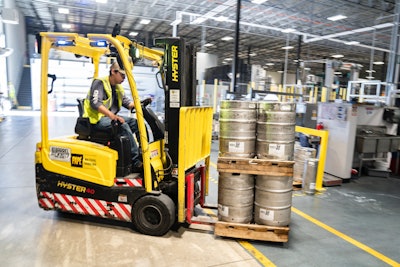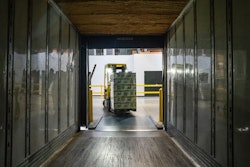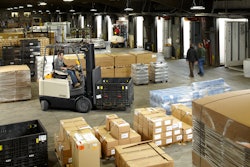
The forklift trucks market is expected to register a CAGR of over 6% during the forecast period (2020 - 2025). Forklift trucks are one of the most common material-handling equipment in the market. Although, there are a large number of automated solutions arriving in the market, the demand for manual internal combustion (IC) and electric forklifts have not dwindled.
- The increasing demand from the European and the Asia-Pacific regions are expected to further increase the sale of these units over the forecast period. While the tremendous demand from the retail industry, especially from the e-commerce sector, is driving the forklift truck market headlong, the advent of automated guided vehicles (close substitutes to forklift trucks) pose a significant challenge to the market.
- However, the uneven weight distribution is due to a more massive rear section to compensate for the loads being carried in the front, which is increasing the chance of tipping over during tight turns.
- It is evident that the energy-consumption costs of an electric forklift is comparatively less. Furthermore, advantages like zero emission, zero noise pollution, and the ability to virtually perform every task that an IC forklift can do, is increasingly approving electric forklift trucks to gain more market share every year.
Read Next: Four Keys to Unlocking Value from Forklift Connectivity
Scope of the Report
A forklift is a powered industrial truck, having two power-operated horizontal prongs that can be raised and lowered for loading, transporting, unloading goods and moving materials over short distances. Forklift trucks can be classified under power source in two different ways, namely internal combustion engine and electric motor. The increasing demand in various industries, such as transportation and logistics, retail sector, general manufacturing, construction, food, and beverage industry is penetrating the forklift market.
Key Market Trends
Electric Forklift Trucks to Hold the Largest Share
- In the past few years, electric/battery-powered forklifts have taken a stronghold in the material handling environment. The limitations and drawbacks that once made electric forklifts inefficient and impractical have been put to rest by advancing technologies and proven performance.
- Many industrial companies are switching to electric forklifts, because energy-efficient, environmentally friendly machines can do virtually anything emission producing IC forklifts do. Electric forklifts are a realistic alternative to liquid-fueled lift trucks and are more economical to operate, equally powerful, easier to maintain, safer, quieter, and cleaner.
- Although the rates of electric forklift depend upon location, it is clear that energy-consumption costs for an electric forklift are far less. Therefore, governments across various countries have been supporting the electric forklifts growth.
- For instance, the Chicago government regulations are pushing materials handling companies to innovate. Owing to this, Hyster Yale introduced two new products of its research and development initiatives, showcasing the company’s first counterbalanced electrical forklift truck with a factory-integrated lithium-ion battery pack.
- With several other advantages, like zero emission, low noise, better visibility, and the knack to virtually perform every task that an IC forklift can do is increasingly consenting electric forklift trucks to gain more market share every and is expected to be the fastest growing forklift type over the forecast period.
North America to Account for the Largest Portion of the Forklift Demand
- According to the estimates of Clark Material Handling Company, US, the industry contributed over USD 25 billion annually to the US GDP, supporting more than 200,000 US jobs annually. As this aligns with the interests of the current US government, to create jobs for US citizens, the sales of this equipment are expected to witness considerable growth in the region over the forecast period, making North America one of the fastest growing regions for the forklift trucks market.
- For instance, in 2019, Toyota Material Handling North America (TMHNA) selected four research proposals to provide the industry with solutions that are smarter, more efficient in terms of new technology and innovative approaches which can help the industry for material handling, warehouse, supply chain, logistics.
- However, the region has witnessed the slowest growth owing to increased penetration as compared to other countries. According to the Material Handling and Logistics Organization, just more than a quarter million units of forklifts were sold in North America, in 2017.
Competitive Landscape
The forklift truck market is fragmented. The increasing penetration of e-commerce in several parts of the world is boosting the demand for electric warehouse pedestrian forklift trucks.
Overall, the competitive rivalry among existing competitors is high. Moving forward, acquisitions and collaboration of large companies with different material handling and supply chain management companies are expected, which are focused toward product expansion and innovation. Some of the key developments in the area are:
- April 2019 - JBT Corporation, a global technology provider announced that it is bringing a new dual-mode AGV to the market in cooperation with Hyster-Yale Materials Handling. The collaboration will help JBT to demonstrate its automated guided vehicle prowess and its commitment to delivering automation to customers around the world with Hyster-Yale on a dual-mode, double-deep pantograph reach forklift truck.
- April 2019 - OTTO Motors, a division of Clearpath Robotics announced the launch of OTTO 750, the first self-driving vehicle for material handling with a payload of 750 kg. It is designed to move pallet-scale loads which would help factories to transport materials. The three standard methods each have different maximum payloads, 100 kg for a cart pushed by a human, 750 kg for a pump truck, and 1500 kg for a forklift.

















